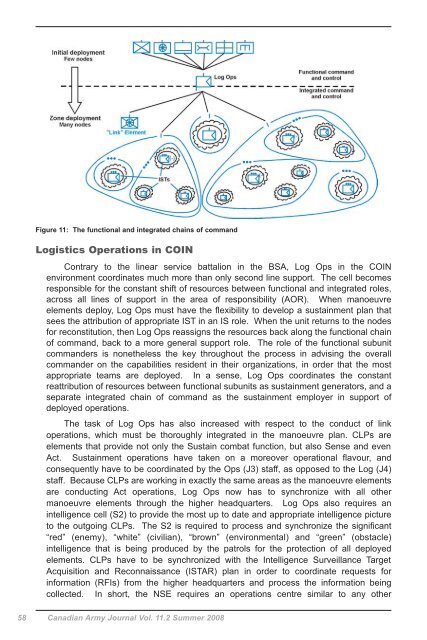Practical Sustainment Concepts for the Non-Linear Battlespace
Practical Sustainment Concepts for the Non-Linear Battlespace
Practical Sustainment Concepts for the Non-Linear Battlespace
You also want an ePaper? Increase the reach of your titles
YUMPU automatically turns print PDFs into web optimized ePapers that Google loves.
Figure 11: The functional and integrated chains of command<br />
Logistics Operations in COIN<br />
Contrary to <strong>the</strong> linear service battalion in <strong>the</strong> BSA, Log Ops in <strong>the</strong> COIN<br />
environment coordinates much more than only second line support. The cell becomes<br />
responsible <strong>for</strong> <strong>the</strong> constant shift of resources between functional and integrated roles,<br />
across all lines of support in <strong>the</strong> area of responsibility (AOR). When manoeuvre<br />
elements deploy, Log Ops must have <strong>the</strong> flexibility to develop a sustainment plan that<br />
sees <strong>the</strong> attribution of appropriate IST in an IS role. When <strong>the</strong> unit returns to <strong>the</strong> nodes<br />
<strong>for</strong> reconstitution, <strong>the</strong>n Log Ops reassigns <strong>the</strong> resources back along <strong>the</strong> functional chain<br />
of command, back to a more general support role. The role of <strong>the</strong> functional subunit<br />
commanders is none<strong>the</strong>less <strong>the</strong> key throughout <strong>the</strong> process in advising <strong>the</strong> overall<br />
commander on <strong>the</strong> capabilities resident in <strong>the</strong>ir organizations, in order that <strong>the</strong> most<br />
appropriate teams are deployed. In a sense, Log Ops coordinates <strong>the</strong> constant<br />
reattribution of resources between functional subunits as sustainment generators, and a<br />
separate integrated chain of command as <strong>the</strong> sustainment employer in support of<br />
deployed operations.<br />
The task of Log Ops has also increased with respect to <strong>the</strong> conduct of link<br />
operations, which must be thoroughly integrated in <strong>the</strong> manoeuvre plan. CLPs are<br />
elements that provide not only <strong>the</strong> Sustain combat function, but also Sense and even<br />
Act. <strong>Sustainment</strong> operations have taken on a moreover operational flavour, and<br />
consequently have to be coordinated by <strong>the</strong> Ops (J3) staff, as opposed to <strong>the</strong> Log (J4)<br />
staff. Because CLPs are working in exactly <strong>the</strong> same areas as <strong>the</strong> manoeuvre elements<br />
are conducting Act operations, Log Ops now has to synchronize with all o<strong>the</strong>r<br />
manoeuvre elements through <strong>the</strong> higher headquarters. Log Ops also requires an<br />
intelligence cell (S2) to provide <strong>the</strong> most up to date and appropriate intelligence picture<br />
to <strong>the</strong> outgoing CLPs. The S2 is required to process and synchronize <strong>the</strong> significant<br />
“red” (enemy), “white” (civilian), “brown” (environmental) and “green” (obstacle)<br />
intelligence that is being produced by <strong>the</strong> patrols <strong>for</strong> <strong>the</strong> protection of all deployed<br />
elements. CLPs have to be synchronized with <strong>the</strong> Intelligence Surveillance Target<br />
Acquisition and Reconnaissance (ISTAR) plan in order to coordinate requests <strong>for</strong><br />
in<strong>for</strong>mation (RFIs) from <strong>the</strong> higher headquarters and process <strong>the</strong> in<strong>for</strong>mation being<br />
collected. In short, <strong>the</strong> NSE requires an operations centre similar to any o<strong>the</strong>r<br />
58 Canadian Army Journal Vol. 11.2 Summer 2008







![La modularite dans l'Armee de terre canadienne [pdf 1.6 MB]](https://img.yumpu.com/17197737/1/188x260/la-modularite-dans-larmee-de-terre-canadienne-pdf-16-mb.jpg?quality=85)









